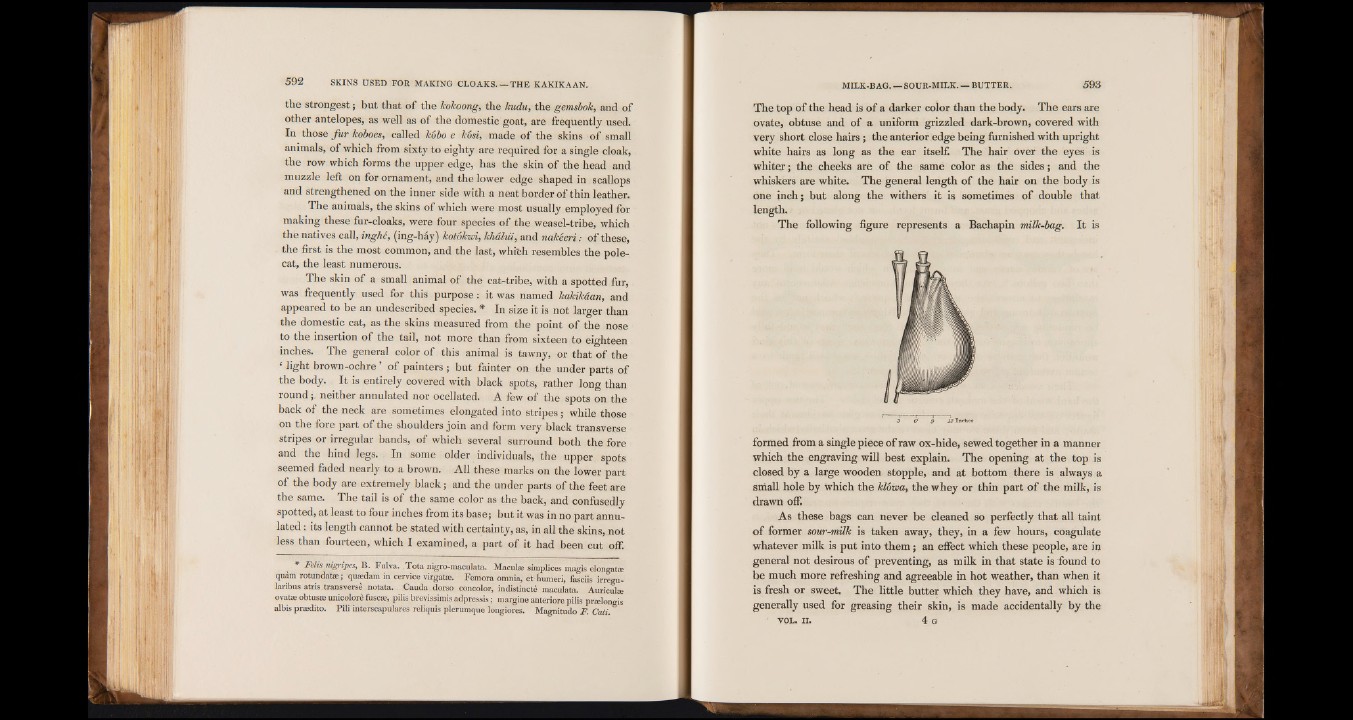
5 9 2 SKINS USED FOR MAKING CLOAKS. — THE KAKIKAAN.
the strongest; but that of the kokoong, the kudu, the gemsbok, and of
other antelopes, as well as of the domestic goat, are frequently used.
In those fur koboes, called kobo e kosi, made of the skins of small
animals, of which from sixty to eighty are required for a single cloak,
the row which forms the upper edge, has the skin of the head and
muzzle left on for ornament, and the lower edge shaped in scallops
and strengthened on the inner side with a neat border of thin leather.
The animals, the skins of which were most usually employed for
making these fur-cloaks, were four species of the weasel-tribe, which
the natives call, inghe, (ing-hay) kotokwi, khdliii, and nakeeri: of these,
the first is the most common, and the last, which resembles the polecat,
the least numerous.
The skin of a small animal of the cat-tribe, with a spotted fur,
was frequently used for this purpose: it was named kakikdan, and
appeared to be an undescribed species. * In size it is not larger than
the domestic cat, as the skins measured from the point of the nose
to the insertion of the tail, not more than from sixteen to eighteen
inches. The general color of this animal is tawny, or that of the
f. light brown-ochre ’ of painters ; but fainter on the under parts of
the body. It is entirely covered with black spots, rather long than
round;, neither annulated nor ocellated. A few of the spots on the
back of the neck are sometimes elongated into stripes; while those
on the fore part of the shoulders join and form very black transverse
stripes or irregular bands, of which several surround both the fore
and the hind legs. In some older individuals, the upper spots
seemed faded nearly to a brown. All these marks on the lower part
of the body are extremely black; and the under parts of the feet are
the same. The tail is of the same color as the back, and confusedly
spotted, at least to four inches from its base; but it was in no part annulated
: its length cannot be stated with certainty, as, in all the skins, not
less than fourteen, which I examined, a part of it had been cut off.
* Felis ™&V>es, B. Fulva. Tota nigro-maculata. Maculae simplices magis elongate
quam rotundatae; quaedam in cervice virgate. Femora omnia, et humeri, fasciis irregu-
laribus atris transverse notata. Cauda dorso concolor, indistinct^ maculata. Auriculae
ovate obtusae unicolore fuscae, pills brevissimis adpressis; margine anteriore pilis praelongis
albis praedito. Plli interscapulares reliquis plerumque longiores. Magnitudo F. Cali.
MILK-BAG. — SOUR-MILK. — BUTTER. 5 9 3
The top of the head is of a darker color than the body. The ears are
ovate, obtuse and of a uniform grizzled dark-brown, covered with
very short close hairs; the anterior edge being furnished with upright
white hairs as long as the ear itself. The hair over the eyes is
whiter; the cheeks are of the same color as the sides; and the
whiskers are white. The general length of the hair on the body is
one inch; but along the withers it is sometimes of double that
length.
The following figure represents a Bachapin milk-bag. It is
3 0' 0 13 Inches
formed from a single piece of raw ox-hide, sewed together in a manner
which the engraving will best explain. The opening at the top is
closed by a large wooden stopple, and at bottom there is always a
small hole by which the klowa, the whey or thin part of the milk, is
drawn off.
As these bags can never be cleaned so perfectly that all taint
of former sour-milk is taken away, they, in a few hours, coagulate
whatever milk is put into them; an effect which these people, are in
general not desirous of preventing, as milk in that state is found to
be much more refreshing and agreeable in hot weather, than when it
is fresh or sweet. The little butter which they have, and which is
generally used for greasing their skin, is made accidentally by the
1 VOL. II. 4 G